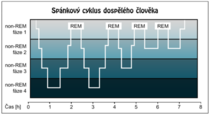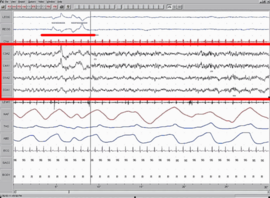Waking and sleeping
The sleep is necessary for the functioning of the nervous system alternates with waking in the circadian rhythm, these are not opposite events. Sleep is a manifestation of a decrease in the CNS → a change in CNS activity: functional manifestations differ from the state of wakefulness ("waking points in the cerebral cortex" -an example is the mother's ability to wake up even at a very weak moan of the baby, while it does not differ from the noise of the surroundings).
Waking[edit | edit source]
Consciousness has two basic meanings: vigilance (vigility X vigilance) and the state of self-awareness and awareness of the reality of the environment. During vigility, there are reactions to common stimuli, with vigilance it is possible to increase the performance of the sensory system and attenuate other systems (for example a cat watching a mouse does not perceive the usual sound stimuli).
Neurophysiological mechanisms of alertness include:
- for the state of vigilance characteristic activity of the ascending facilitation system reticular formation, non-specific. thalamus and some vegetative centers of the hypothalamus;
- collaterals of specific afferent pathways leading to a non-specific ascending activation system, which are necessary for alertness if this afferent decreases (↓ sensor. irritation - darkness, silence) → the individual falls asleep more easily;
- activation of superior structures mediated by reticular formation = arousal reaction;
- the ascending activation system (AAS) is characterized by non-specific action = irritation of any sense → activation of ascending activation system (in addition to awakening also by activation of cortical areas, the limbic system maintains a waking state).
Sleeping[edit | edit source]
Even during sleep, cyclical phenomena take place. The basic division of sleep is into Non-REM sleep (synchronous) and REM sleep (paradoxical). In adulthood, non-REM sleep predominates in a 4: 1 ratio. In neonates, the relative proportion of REM sleep predominates compared to adults. It is assumed that synchronous sleep serves to regenerate somatic functions and paradoxically to restore brain functions. Today, sleep and its quality can be monitored using a smart watch from the home environment.
Neurophysiological mechanisms of sleep[edit | edit source]
Sleep is taken as an active process, generating REM and non-REM by different brain structures.
- Non-REM is characterized by the structures: ncl. raphe, ncl. reticularis thalami, cholinergic neurons reticular formation, ncl. solitary tract, basal structure of forebrain.
- For REM it is: discrete region ncl. reticularis pontis oralis.
Non-REM sleep[edit | edit source]
Slow, sleep with slow waves, telencephalic.
This is the first sleep phase, which is divided into:
Stage 1 - on the EEG breakdown of α activity, replaced by θ activity, somnolence, still obey the calls to open the eyes.
Stage 2 - the person sleeps, does not respond to normally loud speech, in EEG θ activity, interrupted by sleep spindles (waves of rising and falling activity) and K-complexes (slow irregular δ waves before the sleep spindle).
Stage 3 - in the EEG 20–50% δ waves, especially θ waves, less frequent sleep spindles and K-complexes.
Stage 4 - at least 50% δ waves in the EEG, without sleep spindles and K-complexes.
After about 90 minutes, REM sleep begins - irregular EEG, a combination of δ and β activity
REM sleep[edit | edit source]
Activate, paradoxical, rhombencephalic.
During it, the record in the EEG is irregular, the combination of δ and β activity (β-like), muscle tone is lost (especially antigravity muscles (mainly neck), except for eye movement. Muscles - irregular phase contractions - " rapid eye movements " REM). Sympathetic activity predominates = increase of heart frequency, blood pressure and decrease of motility of the GIT, respiratory rate is faster. Dreams appear in REM sleep, there might be erections in men.
Alternation of non-REM and REM phases[edit | edit source]
Per night about 4 cycles (REM / non-REM). REM sleep occupies about 25% of the sleep time, each period lasts 5-20 minutes and this duration is extended during the night. In non-REM sleep, stage 2 accounts for about 50% of sleep time and stages 3 and 4 for about 15% of sleep. Stage 4 appears only in the first half of sleep and stage 3 disappears at the end of sleep. Spontaneous awakening usually occurs in REM sleep.
Sleep ontogenesis[edit | edit source]
During aging, the nature of sleep (periodicity) and its need change. In old age, night sleep becomes less quality:
- awakening increases;
- the deepest stages of non-REM sleep are declining;
- the wake-up threshold decreases.
Links[edit | edit source]
[edit | edit source]
Reference[edit | edit source]
- MYSLIVEČEK, Jaromír. Základy neurověd. 2. edition. Praha : Triton, 2009. ISBN 978-80-7387-088-1.
Kategorie:Neurologie Kategorie:Psychiatrie Kategorie:Fyziologie


